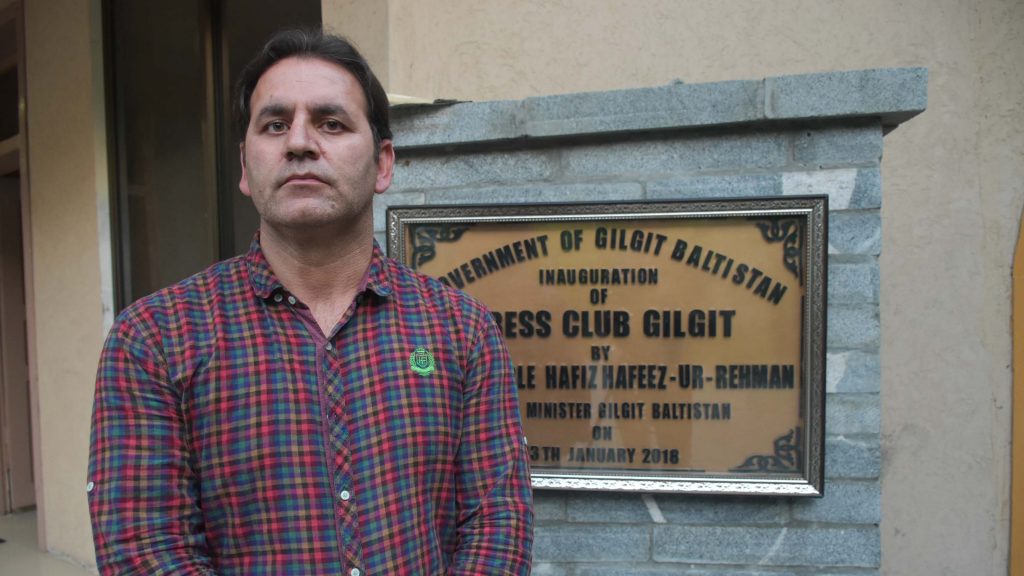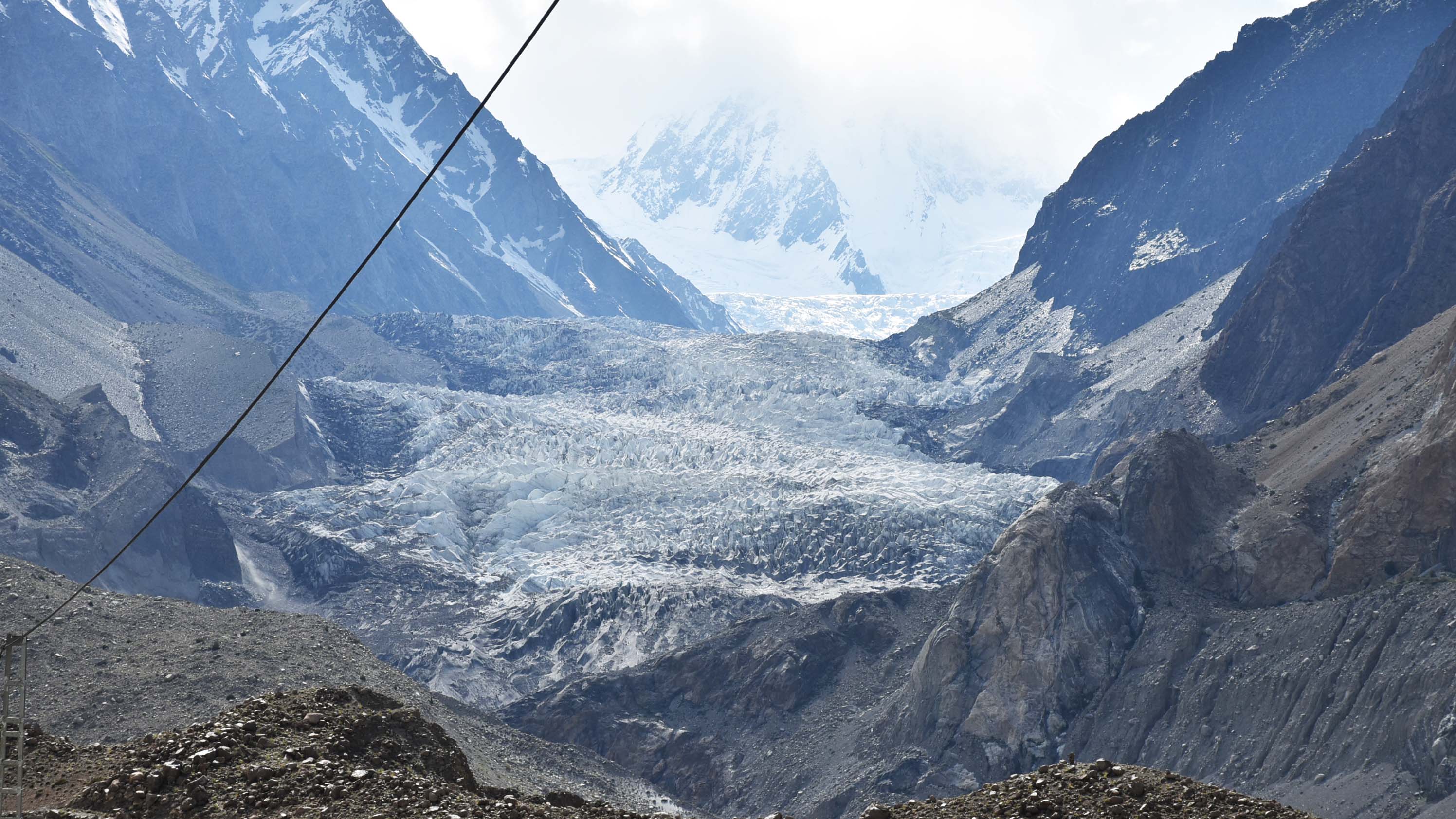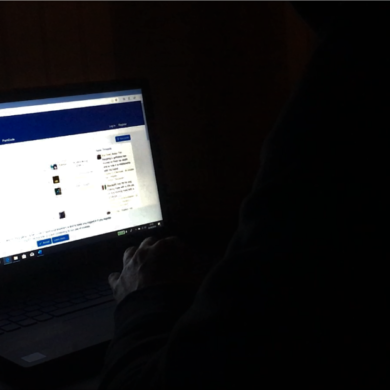With limited government support, the local media of the Hindu Kush Himalayan region struggles to report on the climate
The Hindu Kush Himalayan region spreads across eight nations of South Asia. It is home to the third largest ice mass on earth and known as ‘The Third Pole’. Pakistan is among the eight countries of this region and is home to more than 7000 glaciers.

One of the main tourist attractions on the Karakoram Highway is the Passu glacier 
The Passu glacier is gradually receding owing to the impacts of climate change
But the increasing impacts of climate change in Pakistan call for greater awareness of climate change among the people. The media being the fourth pillar of the state has a role to play in informing the masses on the changing weather phenomenon and what they can do to fight climate change.
A survey ran with 15 journalists affiliated with Gilgit press club highlights the challenges the local media face in everyday climate change reporting.
One of the students from the environmental sciences department, Jameela Parveen, feels that the local media isn’t doing its job effectively. She says, “In Gilgit Baltistan there is event-based reporting of climate change that when a natural calamity strikes the region, only then it receives media attention.”
Jameela further adds, “If the local media regularly shares the threats posed by climate change, it can help to raise awareness among the people. At the moment, the people of Gilgit Baltistan are not aware of the phenomenon.”
Jameela’s views are true to some extent, as BBC’s 2013 Climate Asia report confirmed that 65% of the people in Pakistan don’t even know the meaning of climate change.
The BBC Climate Asia report informs, “Communication can play a key role in supporting people to respond to the impacts of changes in climate by increasing awareness of the issue, its causes and its implications. People have indicated that they need practical information on action they can take, including saving water, changing farming practices to improve crop yields, or learning alternative skills to supplement their income.”
The report highlights the local peoples’ perception on the role of media in covering climate change-related issues. “Many people feel that the media coverage of these issues is inadequate. There is a real opportunity to strengthen media practitioners’ understanding of these issues and support improvement in reporting of them in both local languages and English,” adds the report.
Another survey ran with 78 students of journalism and environment at Karakoram International University (KIU) – a leading university in Gilgit-Baltistan, reveals the perceptions of students on the role of media in communicating the impacts of climate change.
A student from KIU, Shahid Nadeem, who pursues a masters in journalism says, “The media in Gilgit Baltistan should regularly highlight the environmental issues of the region but they are always waiting for any incident to happen. It is actually event-based reporting.”
“The media is not raising awareness and educating the people of the Hindu Kush Himalayan region on the changing climate,” adds Shahid.
The role of media is central to informing the masses on climate change for greater climate action. However the local journalists face several issues that restrict them from effective climate change reporting. Shabbir Ahmed Mir, a senior environmental journalist who works for the Express Tribune in Gilgit Baltistan says, “The biggest hurdle in communicating the climate change impacts is the lack of capacity of the local journalists.” He continues, “One of the reasons being the remoteness of Gilgit Baltistan, as the media trainers do not visit this region frequently to train the local journalists on reporting climate change.”
“With the local journalists of the Hindu Kush Himalayan region unable to produce investigative stories on environment, they limit themselves to producing environmental news when a natural calamity occurs,” shares Shabbir.
On the role of the government in the capacity building of media on environmental reporting, Mir says, “The government only provides trainings on the basic knowledge of journalism but not pertaining to climate change reporting.”
Another journalist, Khalid Hussain from Dunya TV drew attention to the fact that Gilgit Baltistan is witnessing landslides, glacial lake outburst floods and rising temperatures but there is no forum for journalists to highlight these issues. Khalid says,“At times if a journalist wants to publish an environmental story, the media organizations are not willing to take it.”

Khalid also shares his own experience of how the government had once pressurized him from broadcasting an environmental story. “I was planning to produce a programme on Shisper glacier, which was fast melting and could result into a flood. The relevant government official told me to stop promoting sensationalism, as it would create fear among the communities and they would start demanding compensation against the possible loss of property and livestock.”He continues, “When I asked that government official to say on-camera whether the Shisper glacier will trigger a flood or not, he declined to share his views.”
“The government should accept constructive criticism, when it comes to the reporting of climate change and environment,” adds Khalid.
He recommends the government, “to introduce various capacity building programmes for the local print and electronic media journalists for investigative environmental reporting.”
Conservationists believe that raising awareness of climate change holds the key to climate action. According to Dr. Masood Arshad, Director, Climate, Energy and Freshwater, World Wide Fund for Nature-Pakistan (WWF-Pakistan), “Keeping in view of the climate change vulnerability of Pakistan, there is a dire need to raise awareness of the climate change crisis.” He adds, “In this regard, communicating through electronic and print media is an effective way, which can help to inform the mountain communities regarding the climate change impacts.”
“When people are informed about the reality of climate change, it allows them to change their lifestyle and live sustainably,” says Dr. Masood.
Living in a warming world is a reality now and it is up to the local media to inform the mountain communities of Pakistan on what lies ahead. An informed public can lead to better decisions.

